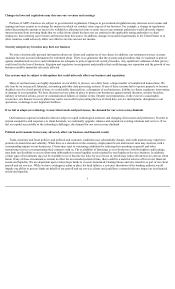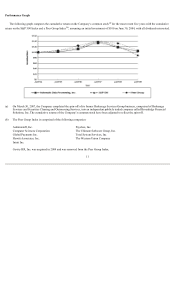ADP 2009 Annual Report Download - page 16
Download and view the complete annual report
Please find page 16 of the 2009 ADP annual report below. You can navigate through the pages in the report by either clicking on the pages listed below, or by using the keyword search tool below to find specific information within the annual report.
Total Revenues
Our consolidated revenues grew 1%, to $8,867.1 million in fiscal 2009, from $8,776.5 in fiscal 2008, due to increases in revenues in
Employer Services of 4%, or $225.3 million, to $6,587.7 million, and PEO Services of 12%, or $125.3 million, to $1,185.8 million. Such
increases were partially offset by fluctuations in foreign currency rates, which reduced our revenue by $188.0 million, or 2%, a decrease in the
consolidated interest on funds held for clients of $74.7 million and a decrease in Dealer Services of 3%, or $42.8 million. The decrease in the
consolidated interest earned on funds held for clients resulted from the decrease in the average interest rate earned to 4.0% in fiscal 2009 as
compared to 4.4% in fiscal 2008, and a decrease in our average client funds balances for fiscal 2009 of 3.1%, to $15.2 billion.
Total Expenses
Our consolidated expenses decreased 1%, to $7,070.4 million in fiscal 2009, from $7,131.0 million in fiscal 2008. The decrease in our
consolidated expenses was due to a decrease of $161.3 million, or 2%, related to foreign currency fluctuations and a decrease in selling, general
and administrative expenses of $172.8 million, which was attributable to lower selling expenses and cost saving initiatives that commenced in
fiscal 2008 and continued in fiscal 2009. These decreases were partially offset by an increase in operating expenses of $186.3 million
attributable to the increase in our revenues discussed above. In addition, there was an increase in pass-through costs in our PEO business
including those costs associated with providing benefits coverage for worksite employees of $102.7 million and costs associated with workers’
compensation and payment of state unemployment taxes for worksite employees of $16.8 million.
Our total costs of revenues increased $159.4 million, to $4,839.5 million in fiscal 2009, from $4,680.1 million in fiscal 2008, due to an
increase in our operating expenses of $186.3 million, partially offset by a decrease in our systems development and programming costs of
$26.2 million.
Operating expenses increased $186.3 million, or 5%, in fiscal 2009 compared to fiscal 2008 due to the increase in revenues described
above, including the increases in PEO Services, which have pass-through costs including those costs for benefits coverage, workers’
compensation coverage and state unemployment taxes for worksite employees that are re-billable. These pass-through costs were $874.8
million in fiscal 2009, which included costs for benefits coverage of $724.3 million and costs for workers compensation and payment of state
unemployment taxes of $150.5 million. These costs were $755.3 million in fiscal 2008, which included costs for benefits coverage of $621.6
million and costs for workers compensation and payment of state unemployment taxes of $133.7 million. The increase in operating expenses is
also due to higher expenses in Employer Services of $64.5 million related to increased service costs for investment in client-facing resources.
Such increases were partially offset by a decrease in operating expenses of approximately $84.0 million due to foreign currency fluctuations.
Systems development and programming expenses decreased $26.2 million, or 5%, in fiscal 2009 compared to fiscal 2008 due to decreases
related to the impact of foreign currency fluctuations of $15.8 million, a decrease in stock-based compensation expenses of $6.5 million and a
decrease in programming expenses related to our systems of $3.9 million. The decrease in programming expenses was a result of a decrease in
the average cost per associate as a larger percentage of our associates are located in off-shore and smart-shore locations. In addition,
depreciation and amortization expenses decreased $0.7 million in fiscal 2009 compared to fiscal 2008 due to decreases related to the impact of
foreign currency fluctuations of $5.4 million, which were partially offset by increased amortization expenses of $4.7 million resulting from the
intangible assets acquired with new businesses and the purchases of software and software licenses.
Selling, general and administrative expenses decreased $172.8 million, or 7%, in fiscal 2009 compared to fiscal 2008, which was
attributable to decreases related to the impact of foreign currency fluctuations of $55.7 million, a decrease in selling expenses related to a
decline in our new client sales of $45.6 million and a reversal of $23.3 million in expenses due to a favorable ruling related to an international
business capital tax. In addition, the decrease is attributable to our cost saving initiatives that commenced in fiscal 2008 and continued in fiscal
2009, which included a reduction in payroll and payroll related expenses of $32.3 million and a decrease in stock-
b
ased compensation expenses
of $16.3 million. Such decreases were partially offset by an increase in restructuring charges, primarily related to severance, of $67.6 million
and an increase in the provision for our allowance for doubtful accounts of $15.5 million due to losses related to our notes receivable from
automotive, heavy truck and powersports dealers.
16
























